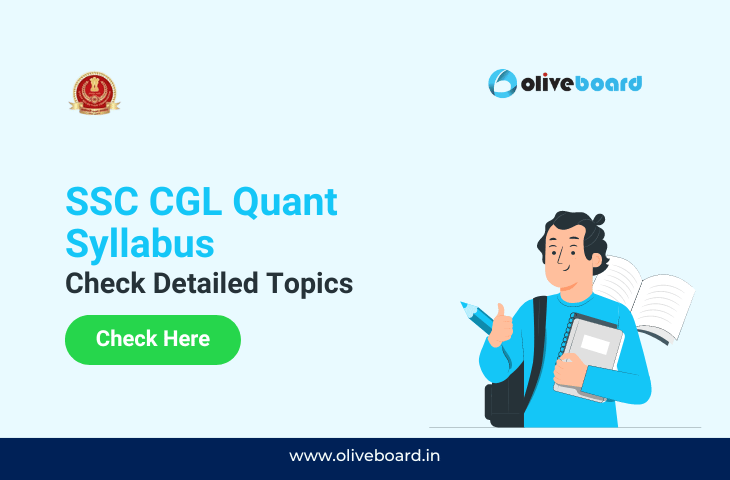SSC CGL Quantitative Aptitude Syllabus
The quantitative aptitude section of the SSC CGL exam holds significant importance as it evaluates candidates’ mathematical proficiency and problem-solving capabilities. Covering a wide spectrum of mathematical concepts such as arithmetic, algebra, geometry, and data interpretation, this section assesses one’s quantitative reasoning skills. A strong performance in this section not only contributes to overall scores but also enhances candidates’ ability to work with numbers. In this blog, we will provide you with the SSC CGL Quant Syllabus 2023.
SSC CGL Quantitative Aptitude Syllabus 2023
- Ratio & Proportion
- Square roots
- Averages
- Interest
- Profit and Loss
- Discount
- Partnership Business
- Mixture and Alligation
- Time and distance
- Time & Work
- Basic algebra
- Surds
- Graphs of Linear Equations
- Triangles
- Circles
- Quadrilaterals
- Regular Polygons
- Circle
- Right Prism
- Right Circular Cone
- Right Circular Cylinder
- Sphere
- Hemispheres
- Rectangular Parallelepiped
- Regular Right Pyramid with triangular or square base
- Trigonometric ratio
- Degree and Radian Measures
- Standard Identities
- Complementary angles
- Heights and Distances.
- Histogram
- Frequency polygon
- Bar diagram & Pie chart
SSC CGL Syllabus and Exam Pattern
SSC CGL Quant Syllabus – Important Points
The quantitative aptitude (quant) syllabus plays a crucial role in the preparation for the SSC CGL exam due to several key reasons:
- Scoring Weightage: The quant section generally carries a significant weightage in the exam, offering candidates the opportunity to secure a substantial number of marks and improve their overall scores.
- Numerical Proficiency: The quant syllabus covers various mathematical topics, including arithmetic, algebra, geometry, and data interpretation. Mastering these topics enhances candidates’ numerical abilities, making them more adept at working with numbers and solving complex mathematical problems.
- Problem-Solving Skills: The quant section assesses candidates’ problem-solving skills and ability to apply mathematical concepts to real-world scenarios. This proficiency is not only vital for the exam but also for facing challenges in professional and everyday life.
- Time Management: Efficiently solving quant problems requires a strategic approach and quick calculations. Developing this skill aids candidates in managing their time effectively during the exam, allowing them to allocate sufficient time to other sections.
- Tier I and Tier II Exams: The quant section is relevant in both Tier I and Tier II exams. A strong foundation established during Tier I preparation serves as a valuable asset when preparing for the more advanced Tier II exam.
- Overall Merit: Scoring well in the quant section contributes significantly to the overall merit and ranking of candidates. A strong performance here boosts their chances of selection and paves the way for a successful career in government services.
- Preparation Strategy: To excel in the quant section, candidates need consistent practice, a clear understanding of concepts, and problem-solving strategies. This approach not only aids in the exam but also enhances their analytical and logical thinking skills.
Conclusion
We hope this blog gave you a better understanding of the SSC CGL Quant Syllabus 2023. To read more such blogs, visit the Oliveboard website!
- SSC CGL Exam Centers 2025 for Tier 1 and Tier 2, Choose Preferences
- SSC CGL Vs CAT, Which is the Better Career Option?
- SSC Typing Test – How to Attempt SSC Typing Test, Check Strategy
- SSC CGL vs IBPS PO Complete Comparison, Which is Better?
- Active Passive Voice for SSC Exams, Practice Questions with Solutions
SSC CGL Quantitative Aptitude Syllabus 2023 – Frequently Asked Questions
Ans. Candidates can find the detailed syllabus in this blog.
Ans. Yes, Quant Section is mandatory in both Tier-1 and Tier-2 of SSC CGL.

Hello there! I’m a dedicated Government Job aspirant turned passionate writer & content marketer. My blogs are a one-stop destination for accurate and comprehensive information on exams like Regulatory Bodies, Banking, SSC, State PSCs, and more. I’m on a mission to provide you with all the details you need, conveniently in one place. When I’m not writing and marketing, you’ll find me happily experimenting in the kitchen, cooking up delightful treats. Join me on this journey of knowledge and flavors!
